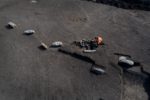 Preventative excavation in advance of highway construction near Veyre-Monton in Auvergne, central France, has unearthed dozens of prehistoric menhirs and a burial cairn containing a human skeleton. The findings could range anywhere from 6,000 B.C. (the Neolithic period) to 1,000 B.C. (the Bronze Age). It is the first time a standing stone complex has been discovered in Auvergne or in central France, for that matter.
Preventative excavation in advance of highway construction near Veyre-Monton in Auvergne, central France, has unearthed dozens of prehistoric menhirs and a burial cairn containing a human skeleton. The findings could range anywhere from 6,000 B.C. (the Neolithic period) to 1,000 B.C. (the Bronze Age). It is the first time a standing stone complex has been discovered in Auvergne or in central France, for that matter.
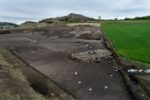 There are 30 monoliths one to 1.6 meters high (ca. 3’3″-5’3″) arranged in an approximately rectilinear alignment over 500 feet. The largest of them are clustered at the top of a slope in north of the site; the smaller ones are set closer to each other at the bottom of the slope. The curated layout along a north-south axis would have made the stones highly visible in the prehistoric landscape. The rectilinear menhirs are aligned with another group of five stone blocks forming an arc or horseshoe shape, and six regularly spaced stones formed into a circle 50 feet in diameter.
There are 30 monoliths one to 1.6 meters high (ca. 3’3″-5’3″) arranged in an approximately rectilinear alignment over 500 feet. The largest of them are clustered at the top of a slope in north of the site; the smaller ones are set closer to each other at the bottom of the slope. The curated layout along a north-south axis would have made the stones highly visible in the prehistoric landscape. The rectilinear menhirs are aligned with another group of five stone blocks forming an arc or horseshoe shape, and six regularly spaced stones formed into a circle 50 feet in diameter.
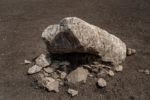 All of the monoliths were deliberately toppled, pushed over into pits. Some of them were damaged. Some were covered with earth. This appears to have been an established practice as it has been found at other monolithic monument sites. It’s possible the removal of the standing stones represented a shift in cultural beliefs.
All of the monoliths were deliberately toppled, pushed over into pits. Some of them were damaged. Some were covered with earth. This appears to have been an established practice as it has been found at other monolithic monument sites. It’s possible the removal of the standing stones represented a shift in cultural beliefs.
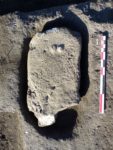 One of the menhirs in the main alignment is unique among its fellows. It is a limestone rock (the others are basalt) and it has been carved. The carvings suggest an anthropomorphic female shape: rounded shoulders on the top, two round protuberances like two very small, close-together breasts. The shapes a were created by carving away at the entire surface of the limestone. Twenty inches below the “breasts” are highly eroded engraved lines forming a chevron that could have referred to arms placed on the belly. This kind of statue-menhir hybrid is very rare in France, and the newly discovered one is the only one ever discovered in Auvergne.
One of the menhirs in the main alignment is unique among its fellows. It is a limestone rock (the others are basalt) and it has been carved. The carvings suggest an anthropomorphic female shape: rounded shoulders on the top, two round protuberances like two very small, close-together breasts. The shapes a were created by carving away at the entire surface of the limestone. Twenty inches below the “breasts” are highly eroded engraved lines forming a chevron that could have referred to arms placed on the belly. This kind of statue-menhir hybrid is very rare in France, and the newly discovered one is the only one ever discovered in Auvergne.
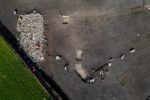 Like the standing stones, the cairn was deliberately flattened to remove it from its prominent place on the landscape. The vertical stones were pushed down into a large pit next to it. It is 46 feet long and 21 feet wide, a rectangle built around a central grave. It contained the skeletal remains of a tall man. His body had been interred in a wood coffin, now decayed, and surrounded with stone blocks. Their size indicates they may have been reused menhirs, perhaps even deliberately broken for reuse in the cairn. It total, 30 tons of stone were transported to this location to build the cairn.
Like the standing stones, the cairn was deliberately flattened to remove it from its prominent place on the landscape. The vertical stones were pushed down into a large pit next to it. It is 46 feet long and 21 feet wide, a rectangle built around a central grave. It contained the skeletal remains of a tall man. His body had been interred in a wood coffin, now decayed, and surrounded with stone blocks. Their size indicates they may have been reused menhirs, perhaps even deliberately broken for reuse in the cairn. It total, 30 tons of stone were transported to this location to build the cairn.
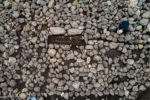 The Veyre-Monton site is a challenging one to date because there were no artifacts found to help identify the period of occupation. The complexity of the construction, including the transport of stones from several different locations, and subsequent destruction indicates a long-term occupation by successive communities, but if they left anything behind other than the stones and burial, it has yet to be discovered. Archaeologists will attempt to determine the dates of occupation using radiocarbon dating of the skeletal remains and of the few traces of organic matter found in the dig.
The Veyre-Monton site is a challenging one to date because there were no artifacts found to help identify the period of occupation. The complexity of the construction, including the transport of stones from several different locations, and subsequent destruction indicates a long-term occupation by successive communities, but if they left anything behind other than the stones and burial, it has yet to be discovered. Archaeologists will attempt to determine the dates of occupation using radiocarbon dating of the skeletal remains and of the few traces of organic matter found in the dig.
please post a follow up when they know more (esp the dating) fascinating, thanks
I wonder if the stone pavement was effectively created as one event, or did people continue to bring stones to add every year? I know that in early Christian saintly sites in Britain people would bring white pebbles to lay beside a cross.